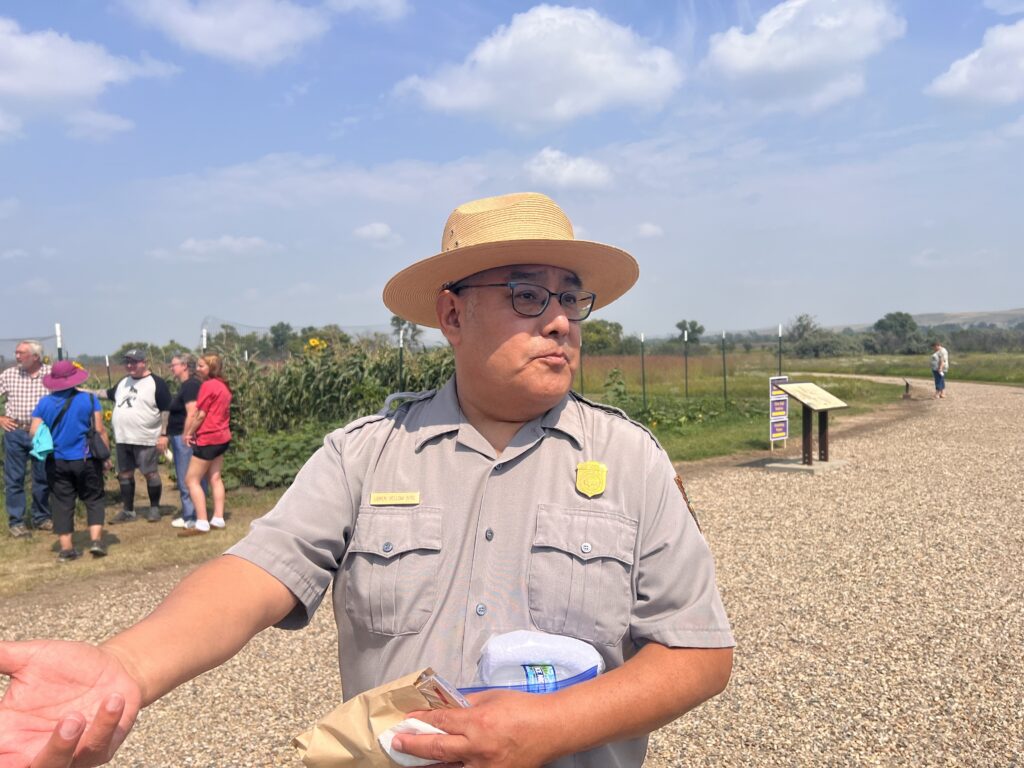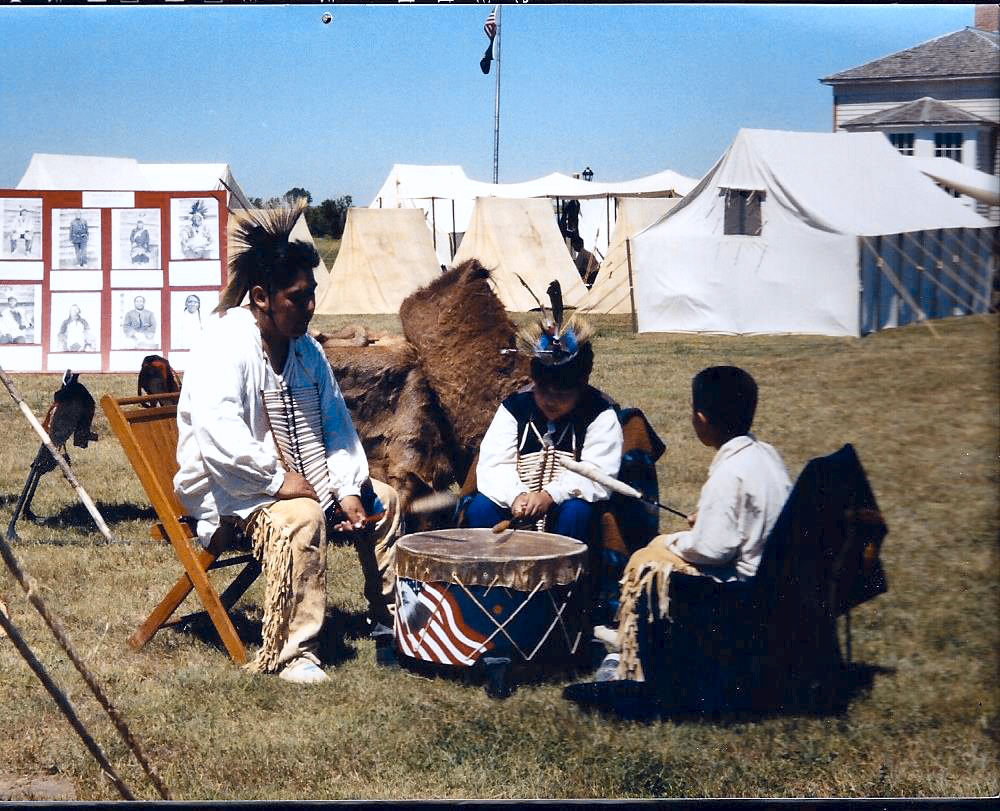
Loren Yellow Bird spent 23 years working as an interpreter at the Fort Union Trading Post National Historic Site, leading tours and speaking at festivities such as the Indian Arts event in 2008. (Photo credit/ Jodi Spotted Bear)
As a Native interpreter for the National Park Service for 24 years, Loren Yellow Bird gets to tell guests a different version of history.
“Fort Union was one of those sites that introduced alcohol and smallpox to the Native people,” said Yellow Bird, a citizen of the Mandan, Hidatsa and Arikara Nation who served 23 of those years at Fort Union Trading Post National Historic Site. I didn’t sit there [and say], ‘Yeah, these guys were really great to all of us and we were so lucky that they came here.’ I put a different spin on it, which I think they want [to hear].”
The interpretive specialist has spent the last year working for the Lewis and Clark National Historic Trail, which covers 4,900 miles from Pennsylvania to Oregon. The trail, which commemorates the Lewis and Clark Expedition from 1804 to 1806, is also a part of the National Trails System. He now works with partner sites to send educational materials to them and assists in providing Indigenous knowledge. Yellow Bird also serves as the vice chairman of the Interpretation, Education and Volunteer Midwest Regional Council of the National Park Service.
“We look at the needs of parks… from basic hiring practices to educational webinars, working with tribes,” he said. “My work is a lot more expansive from the prior work I did at Fort Union.”

As an interpreter, Yellow Bird talked to visitors on a daily basis. He often led school groups on tours, where he talked about the Assiniboine, Dakota and other Indigenous peoples who occupied that region. Many of the schools came from Fort Peck and other parts of Eastern Montana.
Before Yellow Bird joined the NPS full-time, he got his start at the Knife River Indian Villages. He originally went to the site for a school project about earth lodge designs while he was attending what is now known as Nueta Hidatsa Sahnish College. After he left the U.S. Navy Reserve, he had grown interested in learning more about his Arikara and Hidatsa heritage.
“I was never really looking for a career in the National Park Service,” he said. “My initial drive was to try to get involved in the culture and language. I was in the military reserves at that point. Then I had a family and I wanted to do something a little bit more.”
The rangers at the Knife River Indian Villages took notice of the MHA citizen and his interest in the site. Bill Lutz, the chief ranger at the time, gave Yellow Bird a job application and encouraged him to apply. Yellow Bird discussed the opportunity with his then-wife before mailing in the application. At the time he was the father of two sons before having triplet boys in 2001.
Back then, he was working for minimum wage, $3.35 an hour, at his parents’ store in White Shield on the Fort Berthold Indian Reservation near his home. The NPS was offering $8.70 an hour for the summer job. He got hired soon after applying.
“I was driving daily to work from White Shield to Stanton, which took a little over an hour to get there, one way,” Yellow Bird recalled. “I started working with them and then I got very into it. From that point, it just snowballed for the next three [years] after that.”
“I think it’s important because, in the end, we all have a stake in it. We have a history here, our own history, and who better than us, our own people, to be able to tell some of that.”
Loren Yellow Bird- Interpretive Specialist and a citizen of the Mandan, Hidatsa and Arikara Nation
Eventually he took a break from his work to continue his education at North Dakota State University in Fargo. Once Yellow Bird graduated with his bachelor’s degree in history and anthropology, he wavered between going for a graduate degree or beginning his career. At the time, the Fort Union Trading Post National Historic Site was looking to hire an Indigenous interpreter who could discuss the history of the location. In 2001, the NPS offered Yellow Bird a full-time job at the trading post, where he spent the next 23 years of his career.
Since Yellow Bird began working for the NPS, he has also taken assignments in Mount Rushmore, the Badlands, Sand Creek, Bent’s Old Fort and Little Bighorn. Though he doesn’t have a favorite, he enjoyed reconnecting with his culture and talking to folks who came by. “I liked Knife River more in terms of the interactions I had because I had a lot more people from back home coming there.”
Yellow Bird recalls several highlights from his career. Not long after the interpreter began working at Fort Union, his aunt came to the site. “We had a good visit… and then she explained to me that my great-grandfather was born there,” he said. “A man named Joseph Young Bird, who is my mom’s grandpa… So it was really interesting in terms of me having a connection to that site.”
There were some moments during his guided tour when he needed to address racism and cultural stereotypes. During one tour, a man kept interrupting to ask him inappropriate questions. “It got to the point where I just stopped the tour, looked at him… I said, ‘Go, what do you have?’ And so he asked, why are we all alcoholics? And I said, ‘I am a Native man, I don’t drink.’ And then he said, ‘Well, you guys are all uneducated.’ And I was like, ‘You know, I just completed a college degree.’”
Another incident involved third graders from a school just off the reservation. He recalled that two Native girls were the only minorities in the school group. “This little boy was running around, just kept yelling, ‘I’m going to kill every Indian,’” Yellow Bird said. “‘If I see them, I’m going to blast them with my gun. I’m going to kill them!’”
Yellow Bird, who has six children of his own –– five boys and one girl — recalled how bad he felt for the two girls. “I saw these two little girls just sitting there, just with no emotion,” Yellow Bird said. “I come out there, and I said, you better not be trying to do that to no Indians.’ I said, ‘I’m an Indian.’ He stopped, looked at me. This guy that worked for me at the time said it’s against the law to have firearms on a federal site. And the little kid went and sat down real quick.”

The ranger calmly addresses these kinds of situations and tries to use these moments as teaching opportunities. Usually students are excited to meet the MHA citizen. For some children, having Yellow Bird as an interpreter is their first time meeting an Indigenous person. Even though it’s not the current focus of his work, interaction with youth remains important to Yellow Bird. He always tries to answer all their questions, but also makes sure to teach them the Native perspective of history when given the opportunity.
“I think it’s important because, in the end, we all have a stake in it,” he said. “We have a history here, our own history –– and who better than us, our own people, to be able to tell some of that.”
Though Yellow Bird now mostly works from home to collaborate on behind-the-scenes projects, he always invites people to come visit all of the national and state sites. He encourages visitors to learn about the whole history of a place. Most of all, he urges organizations such the NPS to continue giving Indigenous people a voice.
“We’ll be able to do that for as long as we’re continuing to be invited to be part of the conversation –– and I think we have a lot to say,” Yellow Bird said.
Attendees of the 27th Annual Tribal Leadership Summit will have the opportunity to listen to Yellow Bird’s presentation “Our Voice Remains” at 4 p.m. on Sept. 4 in the Prairie Rose Meeting Room, Room 102, at the Bismarck Event Center. Yellow Bird, alongside Walter Echohawk, a Pawnee attorney based in Oklahoma, will explore turn-of-the-century policies and the changes Indigenous people faced during the era of Western expansion. The session will delve into the experiences of tribes in the West throughout the 20th century and will also cover significant legislation such as the Native American Citizenship Act.

